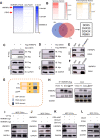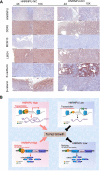HNRNPU promotes the progression of triple-negative breast cancer via RNA transcription and alternative splicing mechanisms
- PMID: 36347834
- PMCID: PMC9643420
- DOI: 10.1038/s41419-022-05376-6
HNRNPU promotes the progression of triple-negative breast cancer via RNA transcription and alternative splicing mechanisms
Abstract
Triple-negative breast cancer (TNBC) is a great detriment to women's health due to the lack of effective therapeutic targets. In this study, we employed an integrated genetic screen to identify a pivotal oncogenic factor, heterogeneous nuclear ribonucleoprotein U (HNRNPU), which is required for the progression of TNBC. We elucidated the pro-oncogenic role of HNRNPU, which can induce the proliferation and migration of TNBC cells via its association with DEAD box helicase 5 (DDX5) protein. Elevated levels of the HNRNPU-DDX5 complex prohibited the intron retention of minichromosome maintenance protein 10 (MCM10) pre-mRNA, decreased nonsense-mediated mRNA decay, and activated Wnt/β-catenin signalling; on the other hand, HNRNPU-DDX5 is located in the transcriptional start sites (TSS) of LIM domain only protein 4 (LMO4) and its upregulation promoted the transcription of LMO4, consequently activating PI3K-Akt-mTOR signalling. Our data highlight the synergetic effects of HNRNPU in RNA transcription and splicing in regulating cancer progression and suggest that HNRNPU may act as a potential molecular target in the treatment of TNBC.
© 2022. The Author(s).
Conflict of interest statement
The authors declare no competing interests.
Figures








References
-
- Siegel RL, Miller KD, Fuchs HE, Jemal A. Cancer statistics, 2021. CA Cancer J Clin. 2021;71:7–33. - PubMed
-
- Gelmon K, Dent R, Mackey JR, Laing K, McLeod D, Verma S. Targeting triple-negative breast cancer: optimising therapeutic outcomes. Ann Oncol. 2012;23:2223–34. - PubMed
-
- Criscitiello C, Azim HA, Jr., Schouten PC, Linn SC, Sotiriou C. Understanding the biology of triple-negative breast cancer. Ann Oncol. 2012;23:vi13–8. - PubMed
-
- Dogan BE, Turnbull LW. Imaging of triple-negative breast cancer. Ann Oncol. 2012;23:vi23–9. - PubMed
-
- Harbeck N, Gnant M. Breast cancer. Lancet. 2017;389:1134–50. - PubMed
MeSH terms
Substances
LinkOut - more resources
Full Text Sources
Research Materials
Miscellaneous

